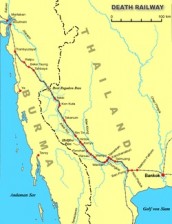Myanmar to reopen ‘Death Railway’—minister
YANGON—Myanmar aims to restore a stretch of the infamous “Death Railway” to Thailand which was initially built by Japanese-held prisoners of war, the minister in charge of the scheme told AFP.
The railway was immortalized in the Oscar-winning film “The Bridge on the River Kwai,” which showed the dreadful working conditions endured by tens of the thousands of POWs who built the track during World War II.
A feasibility study on the 105-kilometer (65-mile) stretch running from Myanmar’s “Three Pagodas Pass” area to Thailand is scheduled to begin in October, Railway Minister Aung Min told AFP late Saturday.
“We will reopen this (rail)road. The other countries said they would also help us and we will continue working for it,” Aung Min said after peace talks with ethnic Shan rebels.
“We will do a survey and try to start working after the rainy season with the help of the international community.”
Article continues after this advertisementLong isolated under decades of army rule, Myanmar has embarked on a rapid series of political and economic reforms under President Thein Sein, including moves to better relations with its neighbors.
Article continues after this advertisementThe railway would provide a much-needed economic shot in the arm for the impoverished area, which is home to Myanmar’s rebellious Karen ethnic group, by boosting trade with Thailand and attracting tourists.
Karen rebels signed a ceasefire with the government in January, a major breakthrough toward ending the long-running insurgency.
Built by the Japanese between 1942 and 1943 to shuttle supplies from Thailand into Myanmar, then called Burma, along a route that engineers had long considered impossible, the rail link was destroyed by Allied bombers in 1945.
Some 13,000 POWs succumbed to abuse, malnutrition and disease during the 14 months it took to carve the 424-kilometer (263-mile) railway through dense jungles and mountains, under orders from their Japanese captors.
It is also estimated that 80,000 to 100,000 Asian civilians, who were also used as forced labor, perished in the railway’s construction but most of their remains have no known markers or graves.
